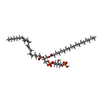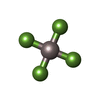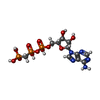+Search query
-Structure paper
| Title | Structural Basis of Substrate-Independent Phosphorylation in a P4-ATPase Lipid Flippase. |
|---|---|
| Journal, issue, pages | J Mol Biol, Vol. 433, Issue 16, Page 167062, Year 2021 |
| Publish date | Aug 6, 2021 |
 Authors Authors | Milena Timcenko / Thibaud Dieudonné / Cédric Montigny / Thomas Boesen / Joseph A Lyons / Guillaume Lenoir / Poul Nissen /   |
| PubMed Abstract | P4-ATPases define a eukaryotic subfamily of the P-type ATPases, and are responsible for the transverse flip of specific lipids from the extracellular or luminal leaflet to the cytosolic leaflet of ...P4-ATPases define a eukaryotic subfamily of the P-type ATPases, and are responsible for the transverse flip of specific lipids from the extracellular or luminal leaflet to the cytosolic leaflet of cell membranes. The enzymatic cycle of P-type ATPases is divided into autophosphorylation and dephosphorylation half-reactions. Unlike most other P-type ATPases, P4-ATPases transport their substrate during dephosphorylation only, i.e. the phosphorylation half-reaction is not associated with transport. To study the structural basis of the distinct mechanisms of P4-ATPases, we have determined cryo-EM structures of Drs2p-Cdc50p from Saccharomyces cerevisiae covering multiple intermediates of the cycle. We identify several structural motifs specific to Drs2p and P4-ATPases in general that decrease movements and flexibility of domains as compared to other P-type ATPases such as Na/K-ATPase or Ca-ATPase. These motifs include the linkers that connect the transmembrane region to the actuator (A) domain, which is responsible for dephosphorylation. Additionally, mutation of Tyr380, which interacts with conserved Asp340 of the distinct DGET dephosphorylation loop of P4-ATPases, highlights a functional role of these P4-ATPase specific motifs in the A-domain. Finally, the transmembrane (TM) domain, responsible for transport, also undergoes less extensive conformational changes, which is ensured both by a longer segment connecting TM helix 4 with the phosphorylation site, and possible stabilization by the auxiliary subunit Cdc50p. Collectively these adaptions in P4-ATPases are responsible for phosphorylation becoming transport-independent. |
 External links External links |  J Mol Biol / J Mol Biol /  PubMed:34023399 PubMed:34023399 |
| Methods | EM (single particle) |
| Resolution | 2.9 - 3.8 Å |
| Structure data | EMDB-12893: Drs2p-Cdc50p in the E1 state EMDB-12894: Drs2p-Cdc50p in the E1-AlFx-ADP state EMDB-12895: Drs2p-Cdc50p in the [PS]E2-AlFx state EMDB-12896: Drs2p-Cdc50p in the E1-AMPPCP state with PI4P bound |
| Chemicals |  ChemComp-2Y5:  ChemComp-MG:  ChemComp-NAG:  ChemComp-HOH:  ChemComp-ALF:  ChemComp-ADP:  ChemComp-Q3G:  ChemComp-ACP: |
| Source |
|
 Keywords Keywords | MEMBRANE PROTEIN / Lipid Flippase / P4 ATPase / trans-Golgi Network / Phosphatidylserine transport |
 Movie
Movie Controller
Controller Structure viewers
Structure viewers About Yorodumi Papers
About Yorodumi Papers












